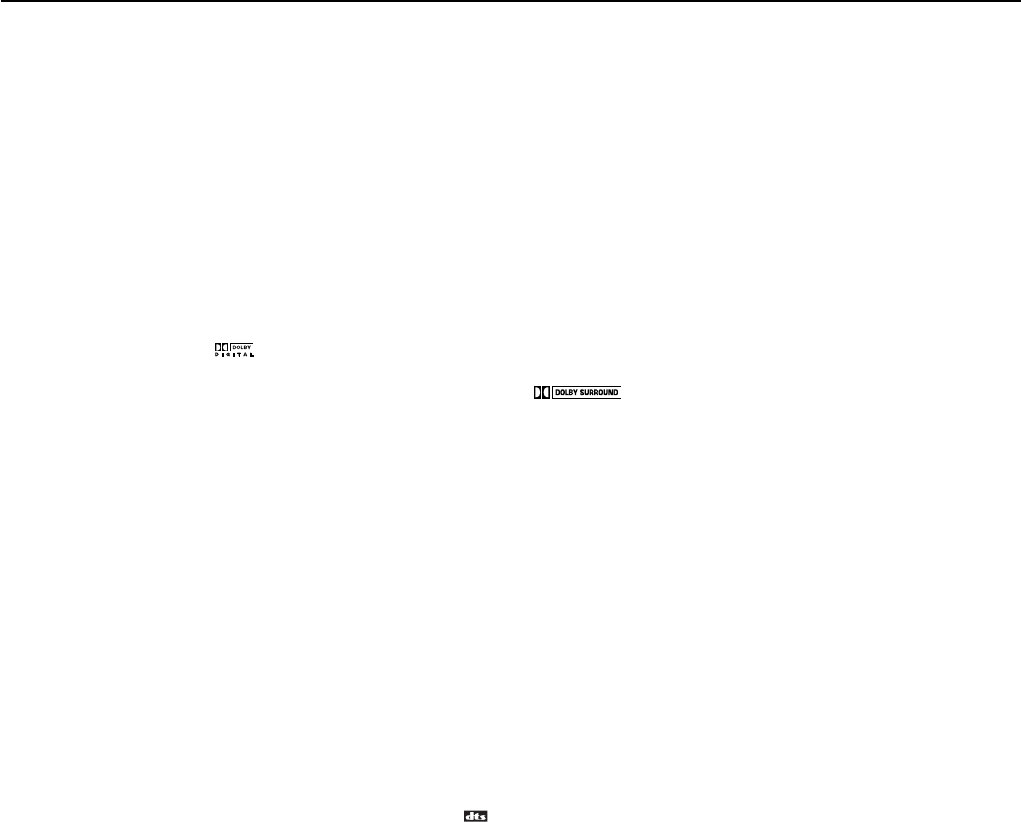
48
Listening Modes
The DTR-6.3/5.3’s surround sound enables you to enjoy the
presence of a movie theater or concert hall in your room.
The configuration of the speakers is very important for the surround
sound. Refer to “Connecting speakers” on page 30.
Before using a listening mode, make sure the Speaker Config,
Speaker Distance, and Level Calibration parameters have been set
(see pages 36 to 39) . Once the parameters have been set, it is not
necessary to set them again. See page 51 for information regarding
how to select the listening mode.
Dolby D (Dolby Digital)
The Dolby D mode is used to play Dolby Digital sources.
Dolby Digital is digital data with AC-3 compression and a maximum
of 5.1-channel* surround sound. This source signal comes from
DVDs and LDs that have the
mark and therefore recorded for
5.1-channel output. This source also comes from digital satellite
broadcasts that support Dolby Digital.
* 5.1-channel Digital Format
The 5.1-channel digital surround format has a variety of versions
including Dolby Digital and DTS. The 5.1-channel digital
surround format enables the individual recording and playing of
five full-range (20 Hz to 20 kHz) channels (left and right front,
center, and two surround channels) plus an LFE channel (Low
Frequency Effect) for the low-range effect sound. It will create a
realistic sound that can be heard in the theaters and concert halls.
Dolby Digital EX
When using surround back speakers, the Dolby Digital source is
played back using the Matrix 6.1-channel decoder.
DTS
The DTS mode is used to play DTS sources.
DTS (Digital Theater System) is compressed digital data with a
maximum 5.1-channel surround output (6.1-channel with DTS-ES
Discrete sources) that allows for an extremely high-quality sound.
This source signal requires a DVD player that supports DTS output
and comes from DVDs, compact discs, and LDs that have the
mark.
DTS-ES Discrete 6.1
With the addition of the surround back channel, this new format has
all 6.1 channels recorded independently for a completely discrete
digital format. Since all channels are recorded independently, high-
fidelity surround playback with the increased feeling of a separated
sound space is achieved.
DTS-ES Matrix 6.1
This format has the surround back channel matrix encoded and
inserted into the left and right surround channels so that at playback
the output for the left, right, and back surround channels are decoded
using a high-precision matrix decoder.
Dolby Pro Logic II
Opposed to Dolby Pro Logic, which had four channels (front, left,
center, and surround) recorded into two channels with matrix
processing and then played back in four channels, Dolby Pro Logic
II uses a feedback logic circuit to have 5.1-channel surround audio
(Dolby Surround, etc.) matrix-encoded into two channels and then
played back in its original 5.1-channel form.
Dolby Pro Logic II provides a Movie mode designed for playing
movies and a Music mode designed for listening to music. In the
Movie mode, the surround channels, which used to provide
monaural output over only a narrow frequency range, now provide
complete stereo output over the full frequency range. The result is
movie viewing with a realistic feel of movement. The Music mode
uses the surround channels to provide a natural soundfield that
cannot be provided with normal stereo output.
This mode can be used with VHS and DVD videos with the
mark and certain television programs. The Music mode
can be used with music compact discs and other stereo sources.
DTS Neo:6
This mode is for 6.1-channel playback of sources such as PCM or
analog sources that have only two channels. The outputs of all six
channels are a wide frequency range with a great separation between
the different channels.
This mode can be set to the Cinema mode designed for playing
movies and the Music mode designed for listening to music.
The Cinema mode is good for movies. The reproduced surround
sound provide the same realistic feel of movement as 6.1-channel
sources. This mode can be used with VHS and television programs
with stereo sound.
The Music mode uses the surround channels to provide a natural
sound space that cannot be provided with normal stereo output. This
mode can be used with music CDs and other stereo sources.
Direct
This mode delivers pure sound with minimum sound quality
adjustment and filtration. The sound recorded for the right and left
front channels is output to the right and left front speakers only and
not output to the subwoofer.
Pure Audio (DTR-6.3 only)
Same as the direct mode except that the pure audio mode also turns
off the display window, turns off the power supply to the video
circuitry, and minimizes the sources of noise. The result is high-
fidelity music playback true to the original source.
Note that if you connect a device to the COMPONENT VIDEO
INPUT jacks of the DTR-6.3, the relay switch activates and signals
are output to the COMPONENT VIDEO OUTPUT jacks. Therefore,
the display on the monitor connected to the COMPONENT VIDEO
OUTPUT jacks will not disappear.
Stereo
This mode has all the input sound output from the left and right front
speakers. The subwoofer is also used for playback.


















